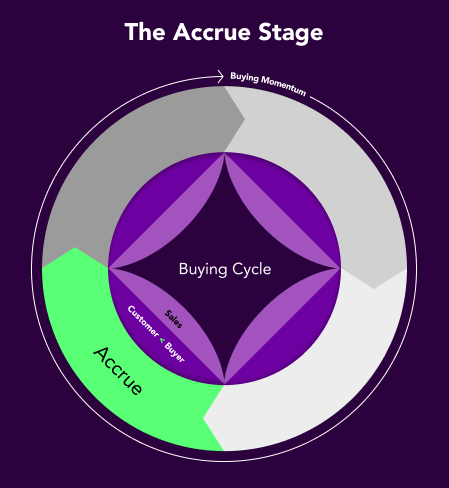The invention of the wheel transformed human existence and altered history unlike any other. It isn’t far-fetched to say that the sales flywheel is the beginning of something similar from a B2B sales point-of-view.
B2B sales funnels centred around the notion of selling cycles are of the era bygone. Unlike the vast disparity among B2B selling cycles across industries and their general unpredictability, B2B buying cycles are way more consistent and foreseeable.
This is where the sales flywheel finds its footing.
What is a Sales Flywheel?
They say the customer is always right. And the sales flywheel reiterates this. If you want to scale your business quickly, you need to ensure the buyer is always at the center of everything you do. The sales flywheel achieves this by allotting every function an integral role within some stage(s) of the sales process.
The sales flywheel can be defined as a cross-functional selling mechanism centred around the archetypal B2B buyer and the stages they go through.
Think of the sales flywheel as a cocoon that nurtures buyers at each stage of the B2B buying cycle. At each stage multiple functions come together to generate buying momentum and pass it onto the next.
When functions work in sync to help move buyers across the flywheel, sales acceleration is multiplied.
Conversely, in the sales funnel, customers are the end-goal of marketing and sales cycles. As a result, sales funnels put a damper on buying momentum and sales productivity.
So how does the sales flywheel work?
The 4 Stages of the Sales Flywheel
The evolution from sales funnel to flywheel is a byproduct of ever changing processes within the world of selling. Processes that have changed as a result of prevailing buyer centrism.
The 4 stages of the sales flywheel bring together the marketing, sales, customer success and product functions to keep buyers satisfied at each stage. Buying momentum is built up across these 4 stages in the following order:
1. Filter
The first stage of the flywheel is filtering out leads from prospects. Remember, what goes into your flywheel determines the end result. Whether your flywheel is jerky or smooth rolling is all down to how well you filter what goes in.
In the filter stage, only those prospects that will move the quickest from the unaware to the decision stage should be allowed to enter the sales flywheel.
To understand this better, here are some definitions:
A lead can be any decision maker that may have a use for your product but are yet to realize their need for it.
A prospect is a lead that has become aware of your product and their need for it, but is yet to show any concrete interest towards purchasing it.
A lead isn’t yet worth your while as they aren’t going to make a purchase decision anytime soon, and will take away buying momentum from your flywheel.
Both marketing and sales have a part to play in filtering out leads from prospects. Here’s the breakdown of each of their roles:
Marketing’s Role
Your digital real estate should be optimized to sieve out leads that aren’t going to buy your product anytime soon, if at all. This will ensure only prospects that are gearing up to make a purchase decision are entering your flywheel.
Everything from your inbound strategy, content, ads, social media, webinars, newsletters, marketing automation, activity tracking, and CTAs serve as inbound filters. Each filter ensures only viable prospects pass through them.
In the process, appropriate leads are educated about their pain points, realize their need for your product, and smoothly flow into your flywheel as filtered prospects.
Sales’ Role
The beauty of the flywheel is that it covers both inbound and outbound motions. Outbound filtration is a crucial part of a smooth rolling flywheel. If your outbound team isn’t filtering out who they’re reaching out to, your flywheel is going to run at half its capacity.
During the prospecting phase, sales teams gauge leads’ propensity to purchase your product through their research and interactions with them. This helps verify whether they’re a lead or a prospect.
Learn about how you can effortlessly research, filter out leads, prioritize and win over high-intent prospects in this prospecting guide.
2. Propagate
Once prospects have familiarized themselves with your product, they can move towards making a purchase decision and thus become buyers.
With the bad seeds picked out, in the first stage, good-fit prospects move into the propagation phase to be nurtured into buyers.
Both marketing and sales play key roles in prioritizing and ensuring viable prospects convert into buyers. They are as follows:
Marketing’s Role
There are a few channels through which marketing can propel B2B prospects into buying mode. Some of them include:
- Free trial sign-ups
Once the prospect is convinced enough about your product, they generally move onto signing up for a free trial. This active interest in trying out your product first-hand allows them to evaluate their decision to purchase.
- Product collateral downloads
Prospects, hungry to know more about the product, download collateral in exchange for contact details. This allows them to evaluate their purchase decision and convert into buyers.
- Website
Prospects tend to scout around a brand’s website to find useful information about the product, helping them narrow down on a purchase decision. Testimonials, comparison, feature, and other product pages help hasten this process.
- Nurture campaigns
Nurture campaigns with the objective of further exposing a prospect to the product, brand, and features helps nudge them into a buying decision. They also get the chance to stay up-to-date with the latest developments.
- Book a demo CTAs
The final phase of every prospect evaluating a purchase generally ends with a book a demo CTA. Prospects seek to connect with sales teams to learn more about the product via these CTAs on your digital real estate.
Once demos are booked, the baton is passed onto the sales team to follow-up with prospects, conduct demos and see whether they are ready to purchase. Marketing’s role is to prioritize prospects to pass onto the sales team based on their propensity to buy.
High purchase intent prospects are moved onto the sales team for quick closures while the rest are allowed to further warm up, or tossed out of the flywheel altogether.
Sales’ Role
Sales outreach follow-ups and re-reaching out to prospects that are being nurtured towards a buy help gauge how far they are from a purchase decision.
Based on their propensity to buy, prospects are run through demos on a priority basis. Demos allow sales teams to vet prospects toward a buy, and clear any queries and concerns.
Once the demo is completed, and everything is out of the way, the prospect is ready to make a purchase decision and turns into a buyer.
3. Accrue

Having spent all that time and effort on vetting a buyer, it’s now time to accrue your returns.
If the buyer decides to make a purchase decision in favor of your product, they are on the verge of becoming a customer. Things are all but done in the accrual stage as the burden shifts entirely onto the sales team.
Again, sales teams prioritize buyers based on their propensity to purchase for closure. Negotiating pricing, legal paperwork, and payment processing are some of the steps required to get the deal across the line.
Once this is complete, you now have a customer. But it doesn’t end here.
4. Iterate
The next step involves iterating customer experience to evangelize customers, generate upsells, and prevent churn.
Ensuring that customers stay happy is possibly the most important part of any business. This is why customer success, product and marketing teams have to come together to iterate and optimize customer experience.
This begins with customer success teams developing a strong relationship with customers right from the get-go. From helping them onboard to getting on periodic calls to evaluate and optimize success metrics, the CS team plays an integral role in evangelizing, upselling, and winning contract renewals.
A few other things that help appease customers include support quality and feedback implementation. To do this customer success teams need to to work closely with product and product marketing teams.
The product team needs to plan, prioritize and build out their roadmap based on customer feedback and requirements. New features, product improvements and updates that are customer-centric are key to keeping customers happy.
Product marketing on the other hand should ideally continue to nurture customers through emails, newsletters and other mediums. These should seek to keep customers up-to-date, optimistic about the product, and guide them towards optimizing their experience and productivity.
If customer success, product, and marketing work together to raise customer spirits, you now have evangelists.
And what do evangelists do?
5. The Flywheels on the Bus Go Round and Round
Summing It Up: What Is a Flywheel Sales Model?
In a sales flywheel, buying momentum is further potentiated with each rotation. Each rotation is only made possible by the coming together of functions to push buyers into the next stage of the buying cycle. As a result the flywheel continues to spin faster and faster and faster.
Evangelists help complete the circle by transmitting all that built up buying momentum back to stage one for it to multiply yet again. Whether it’s testimonials or reviews or word-of-mouth referrals, evangelists are crucial in transferring buying momentum back to the filter stage.
Hypersonic Sales Flywheel: The RevTech Revolution
If sales processes are to keep changing on the basis of buyers’ whims, why did we ever base them off selling cycles in the first place?
But it’s not just transformative processes that have powered this evolution, but also our ability to crunch buyer data and make it more coherent, comprehensible, and thus more predictable.
In terms of processes, unified functions can talk to each other and work together more efficiently through accurate data. Each function’s data isn’t just restricted to individual filters and siloes today, but rather comes together to deliver momentum shaping insights that will supercharge your flywheel.
And so from evolution to revolution, Slintel, despite growing 5X year-on-year, has decided to go all-in and join the RevTech revolution with 6sense, helping pave the future of GTM.
Reach out to us if you’d like to explore this future, and set your flywheel on hypersonic autopilot.






